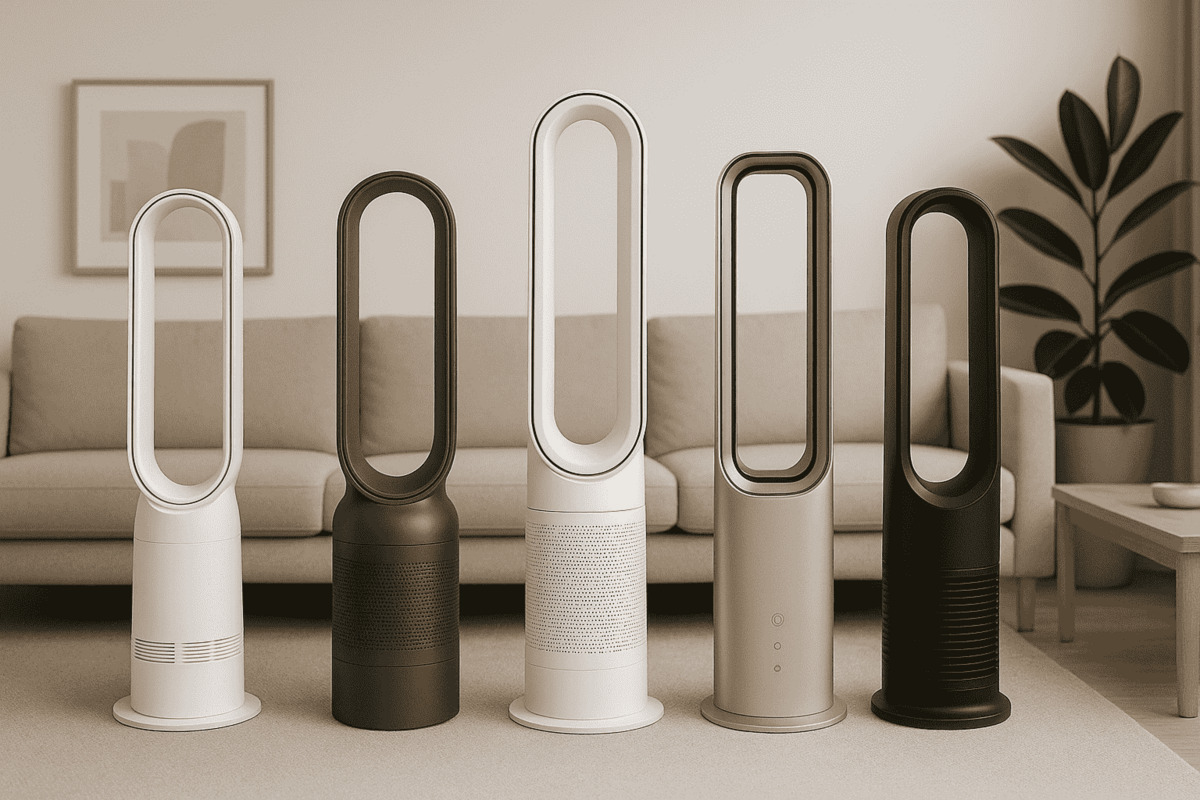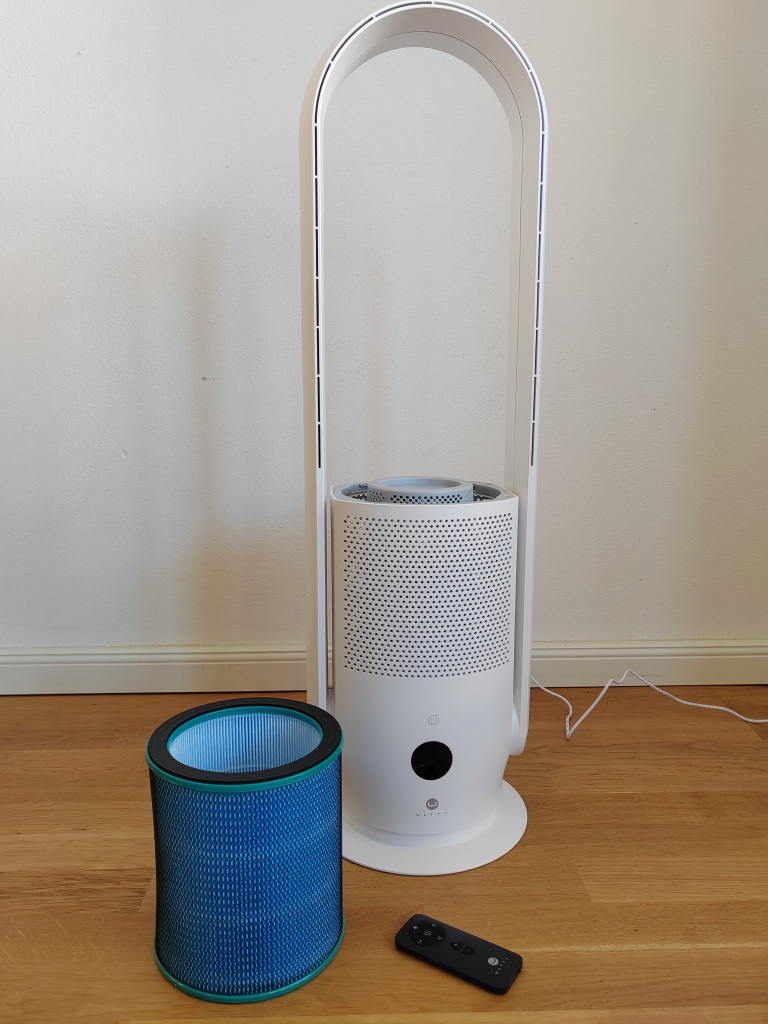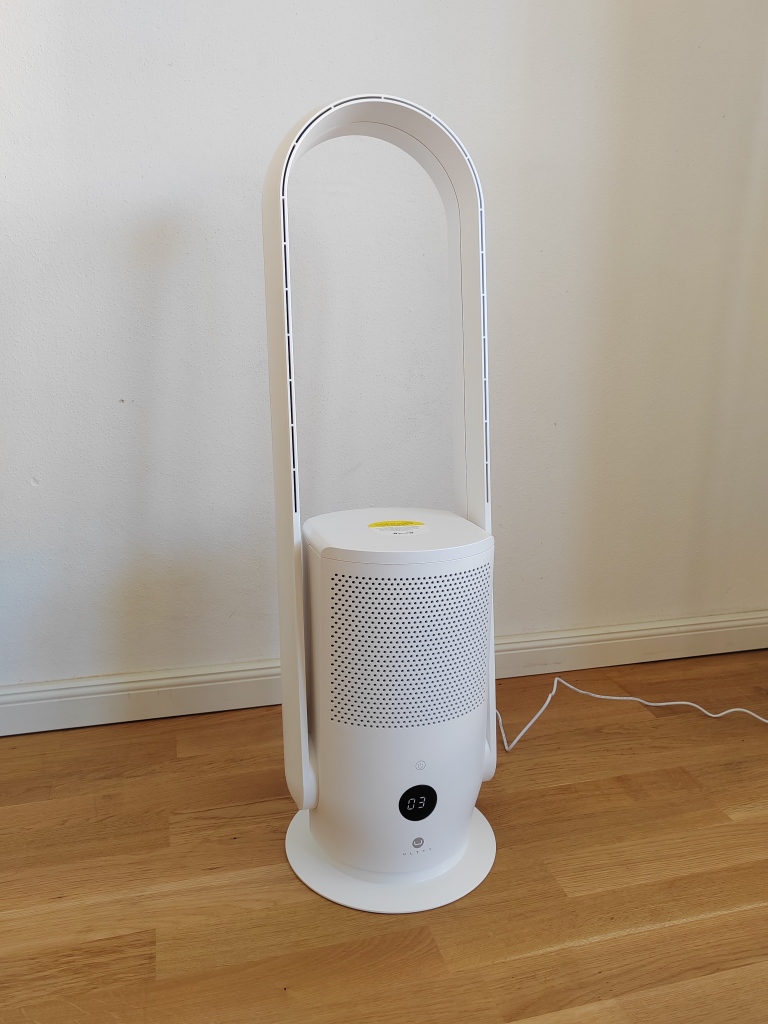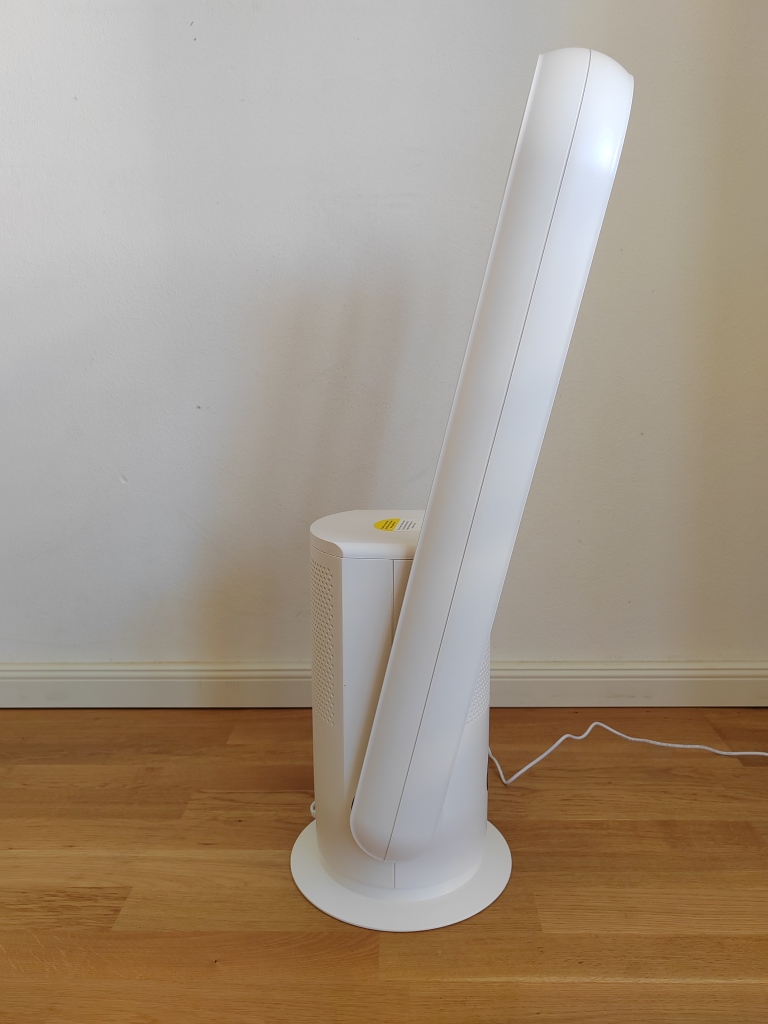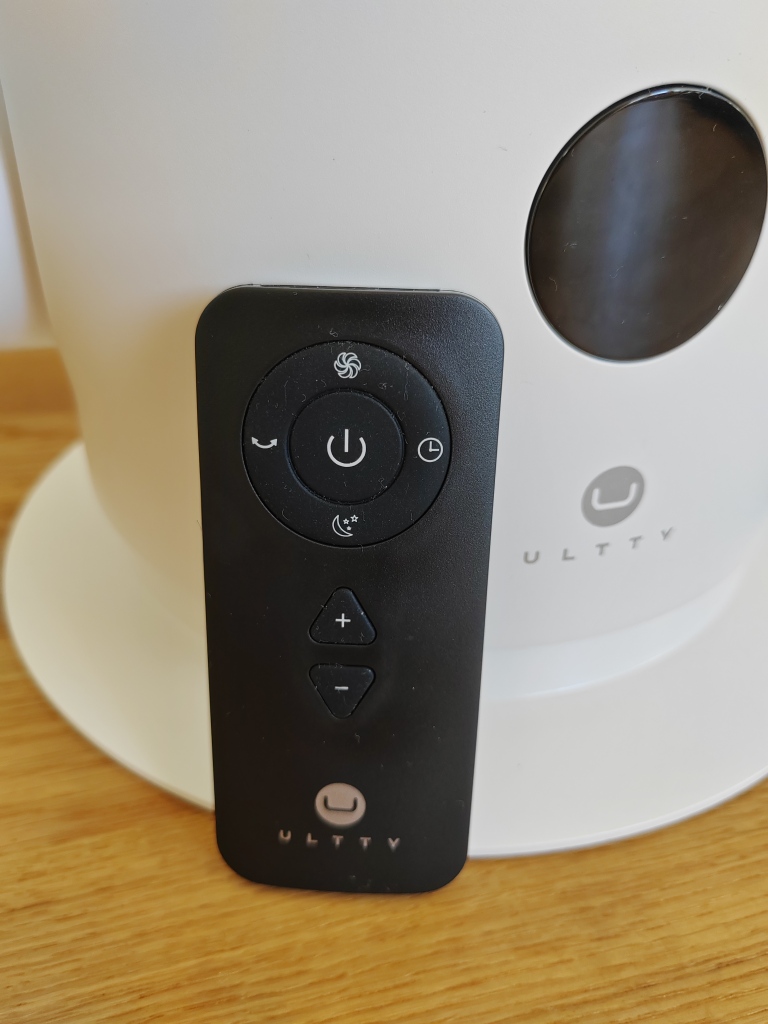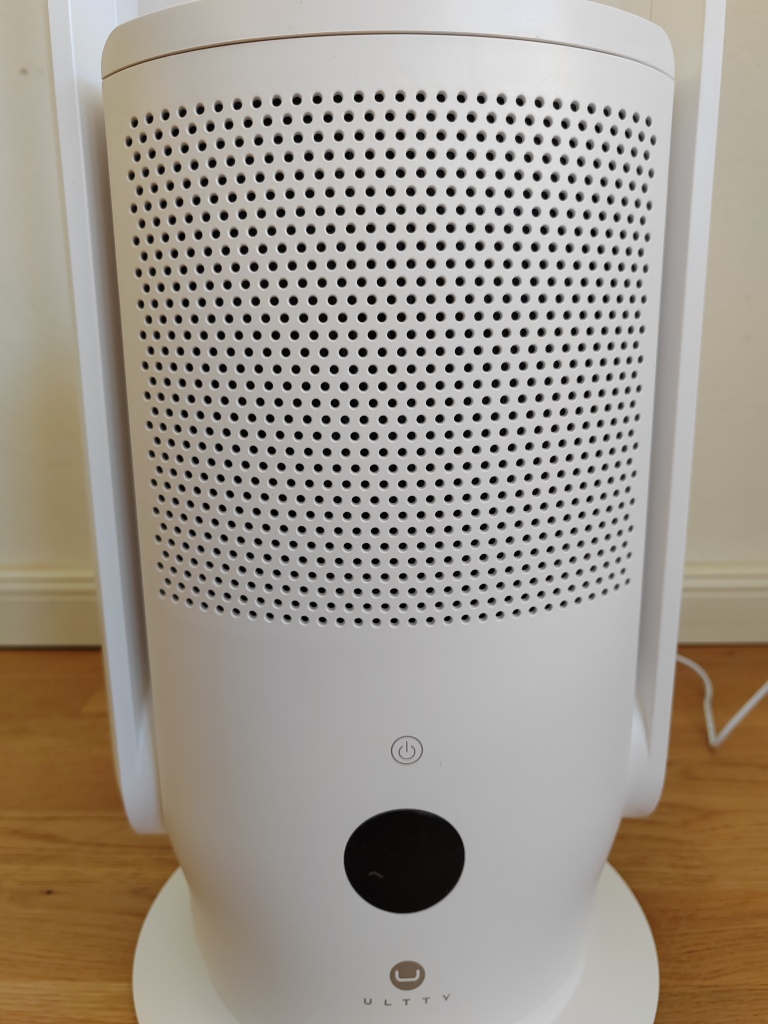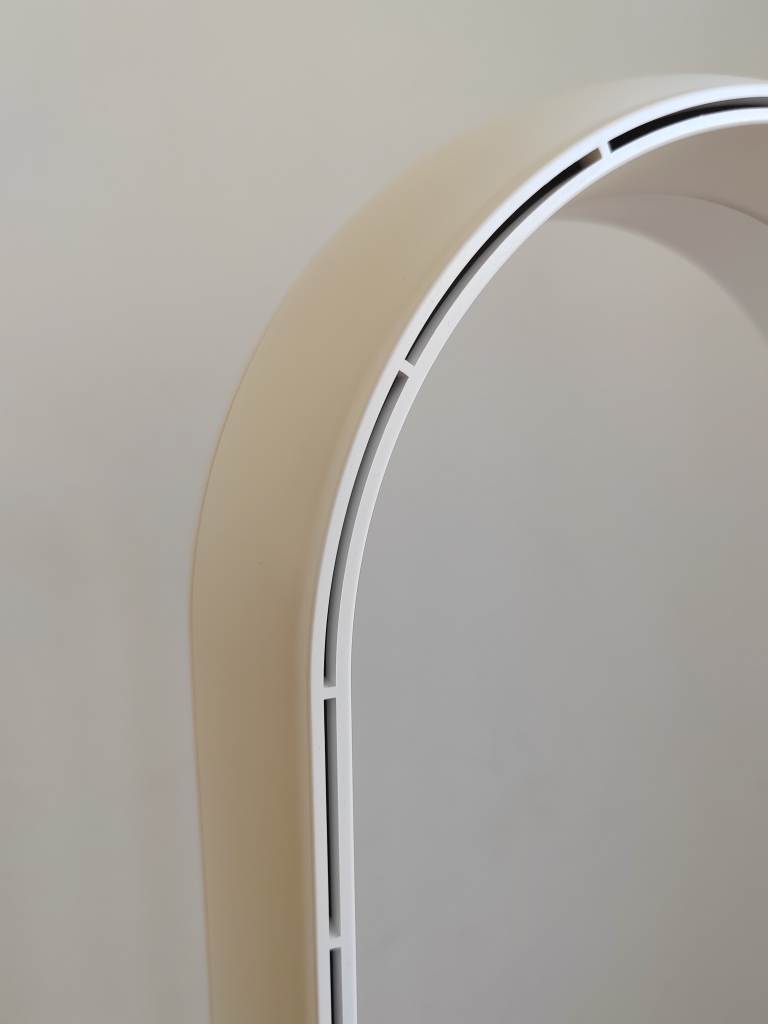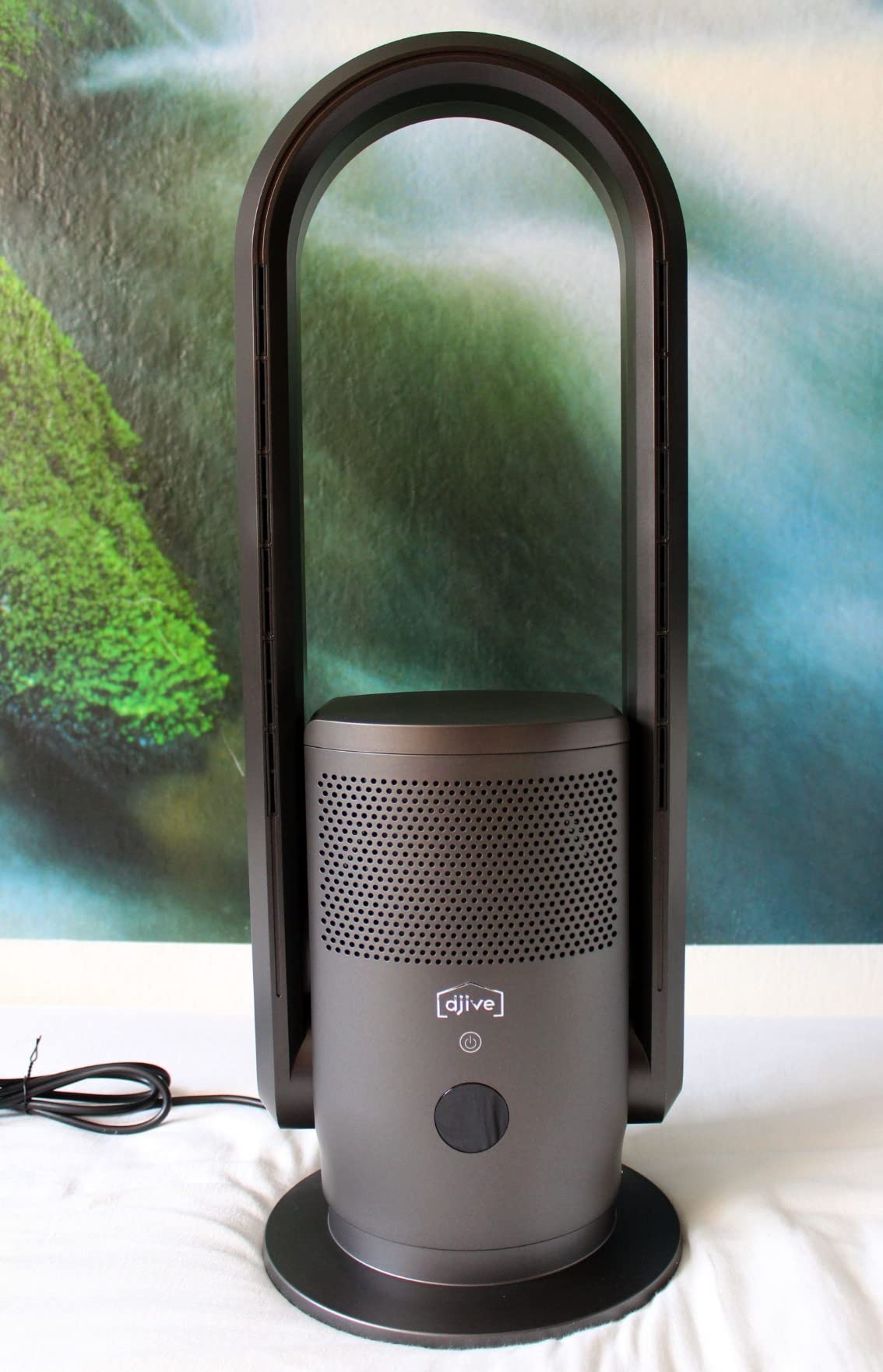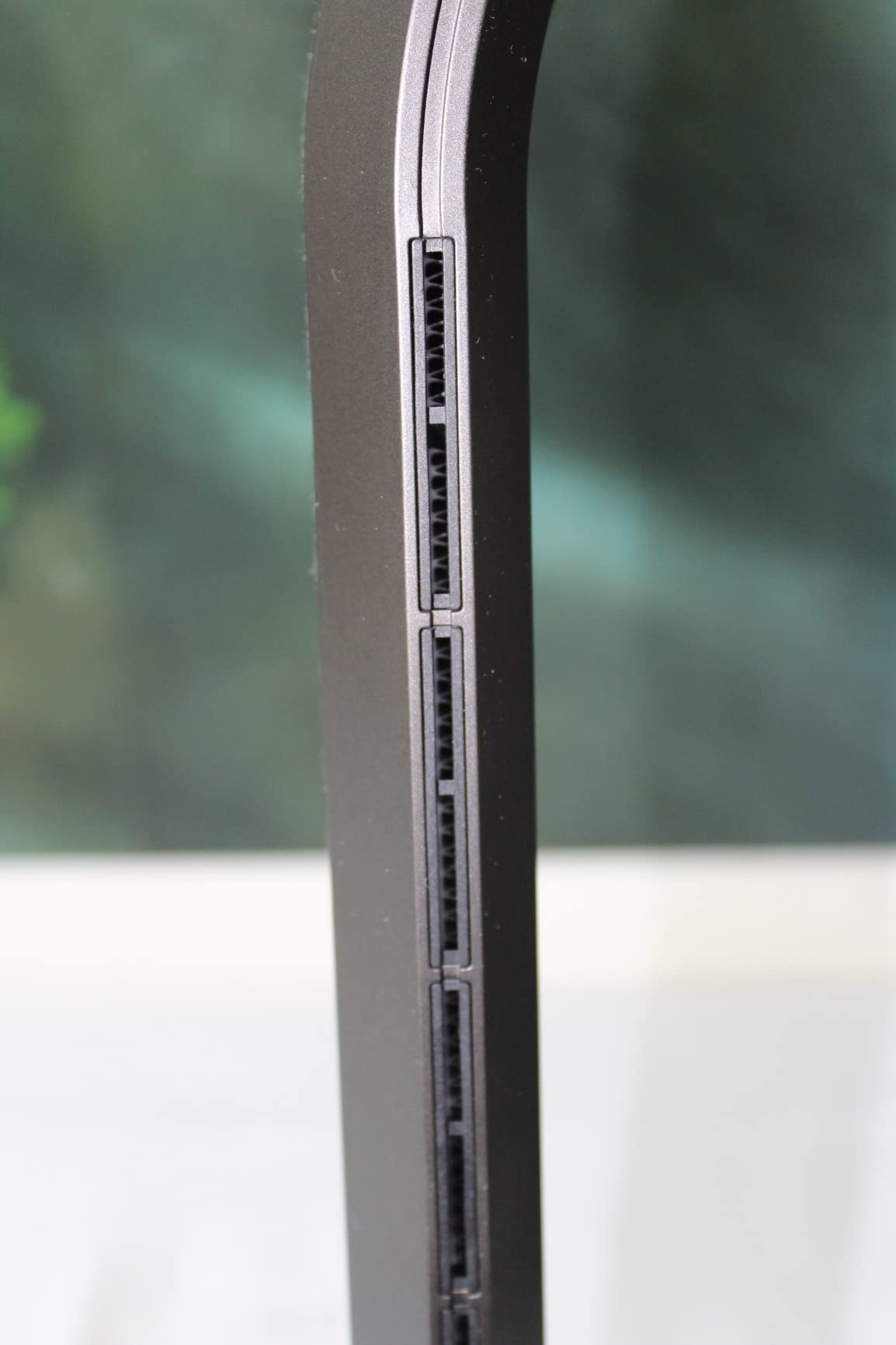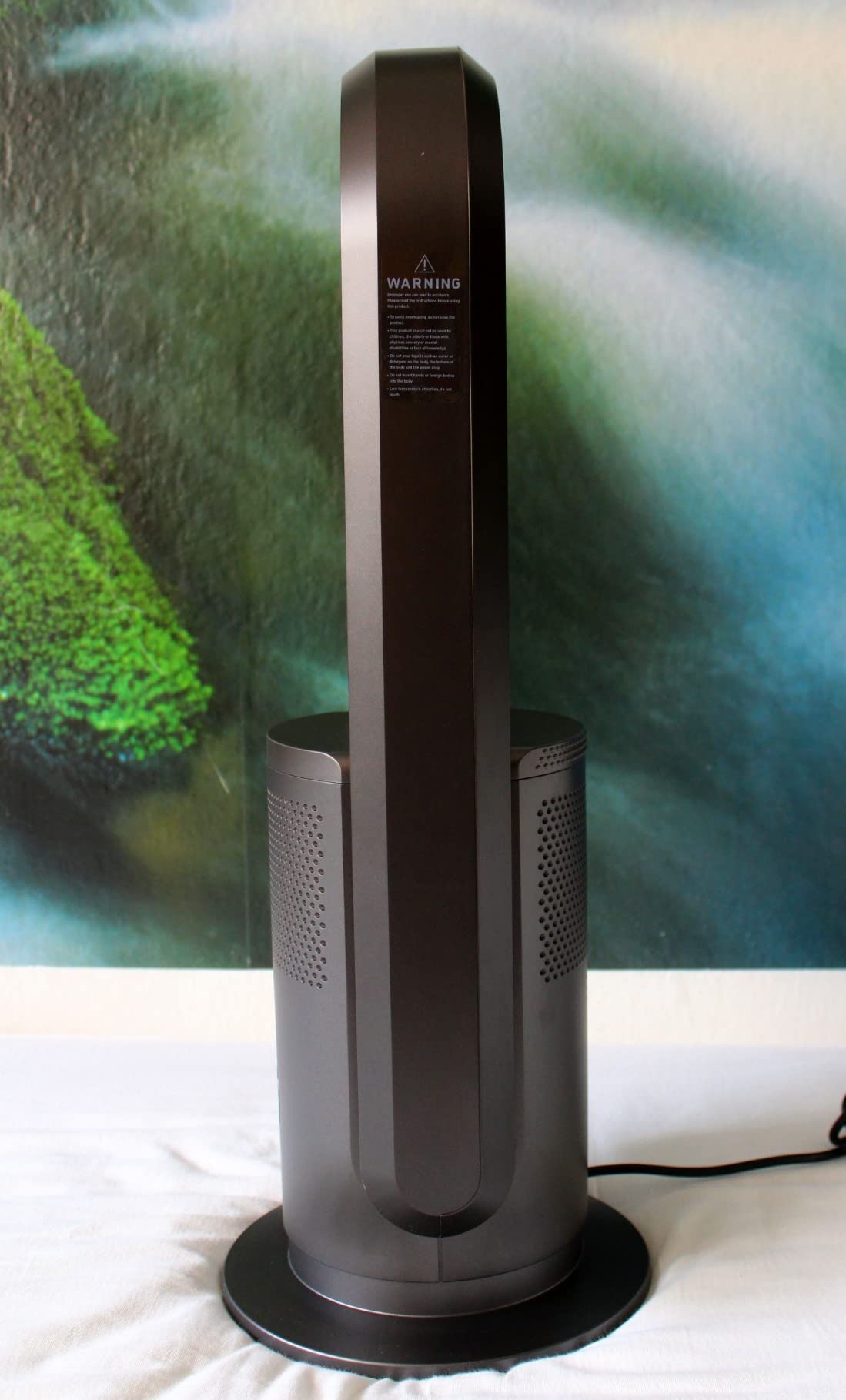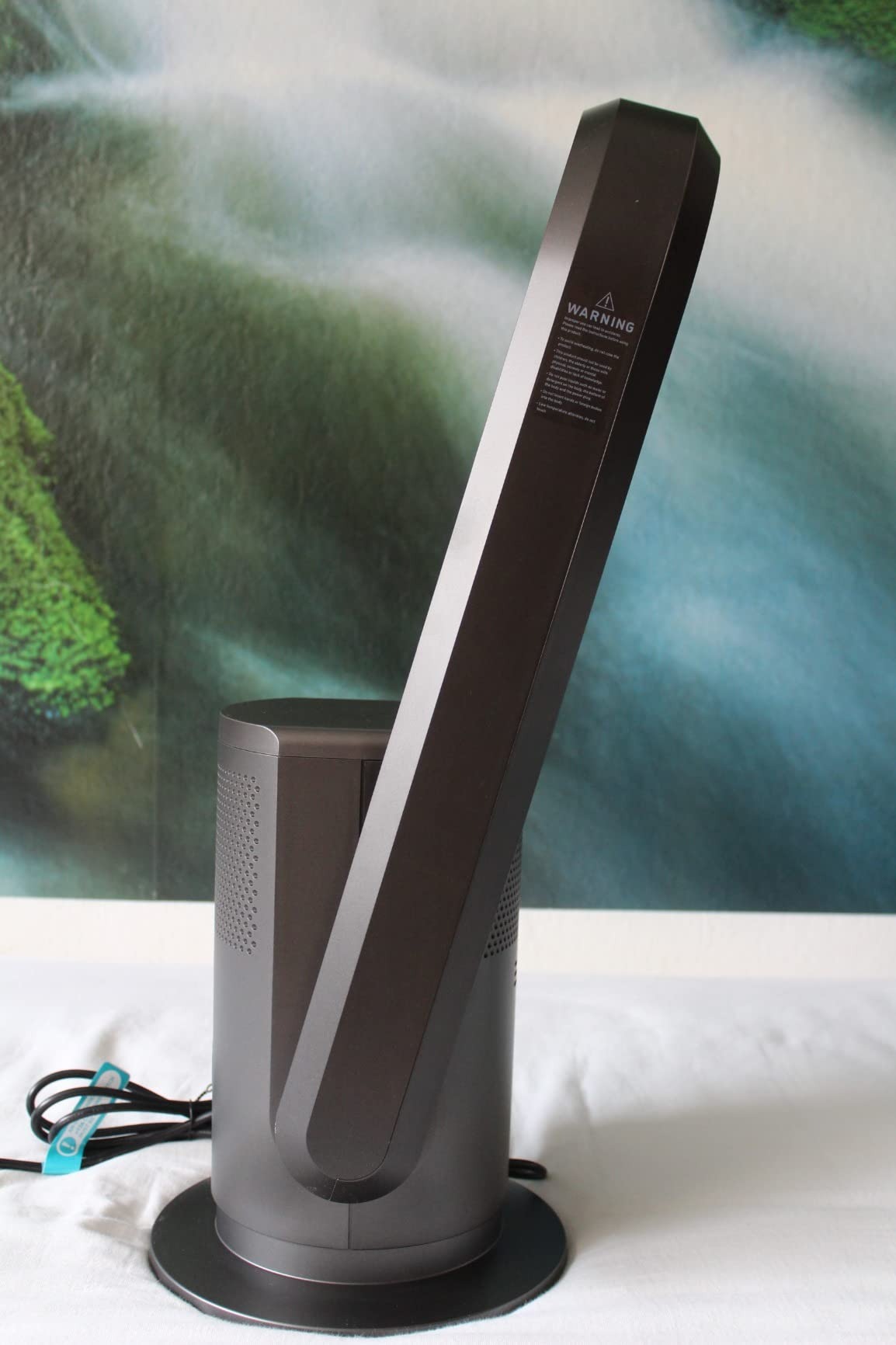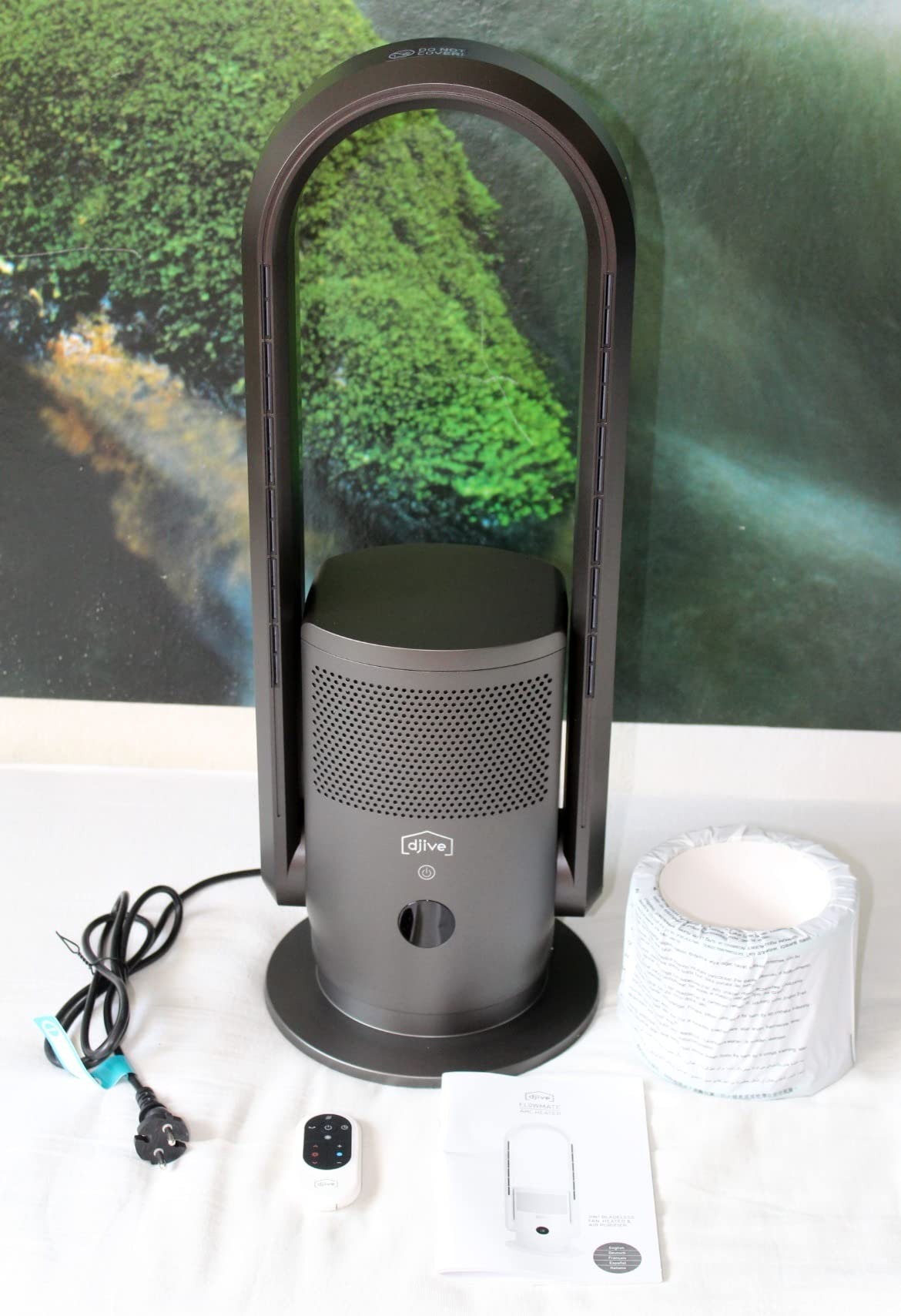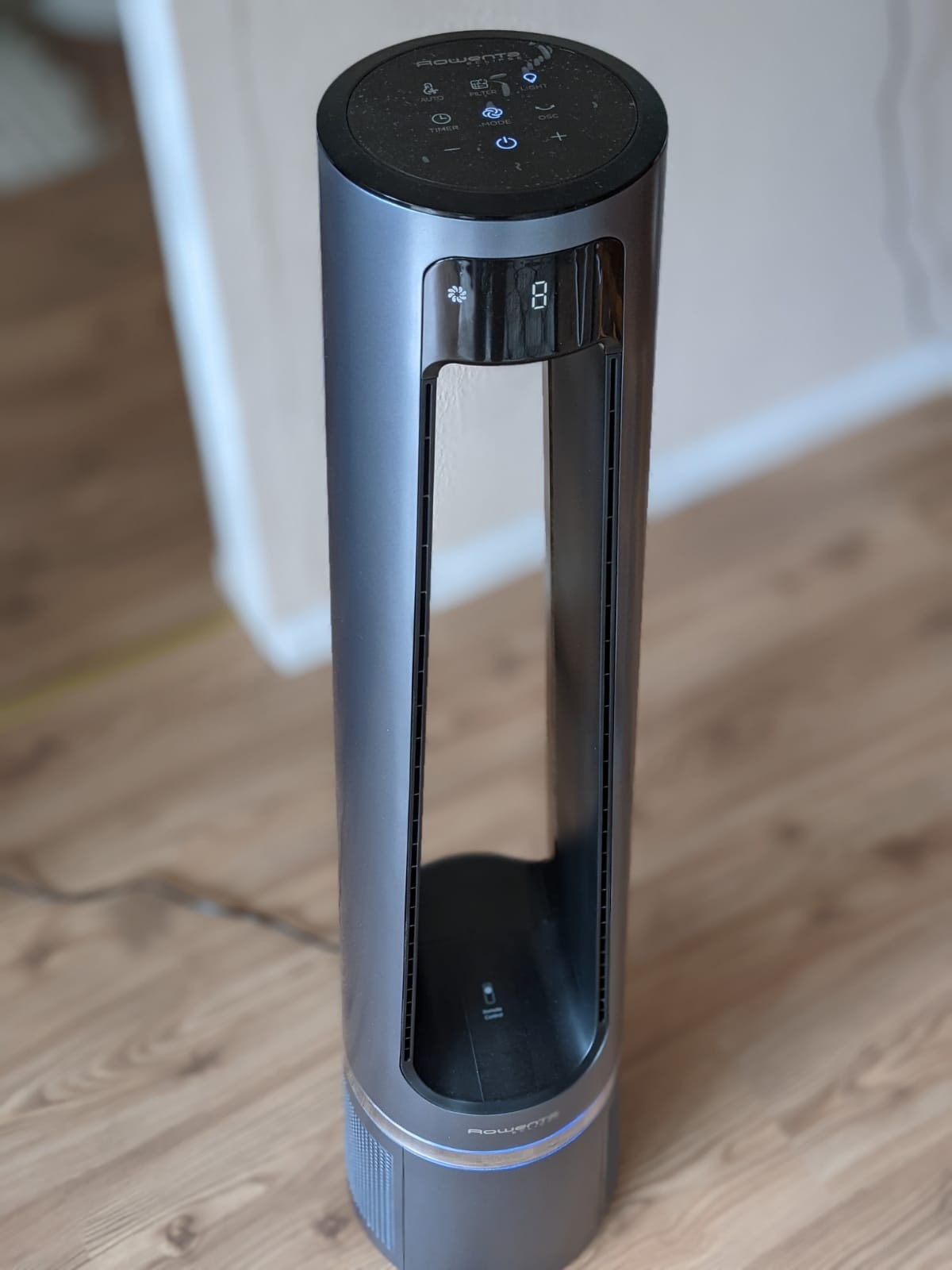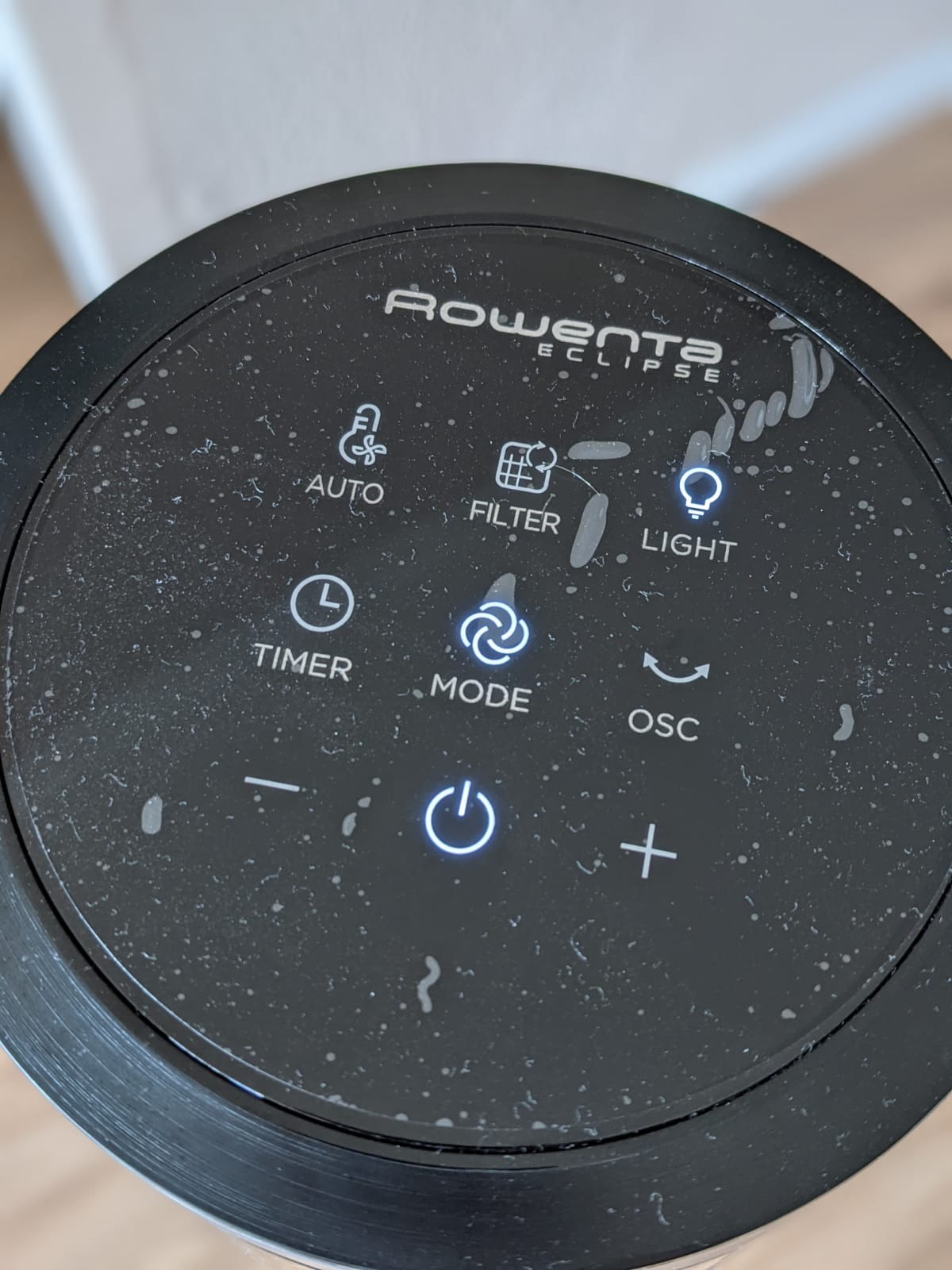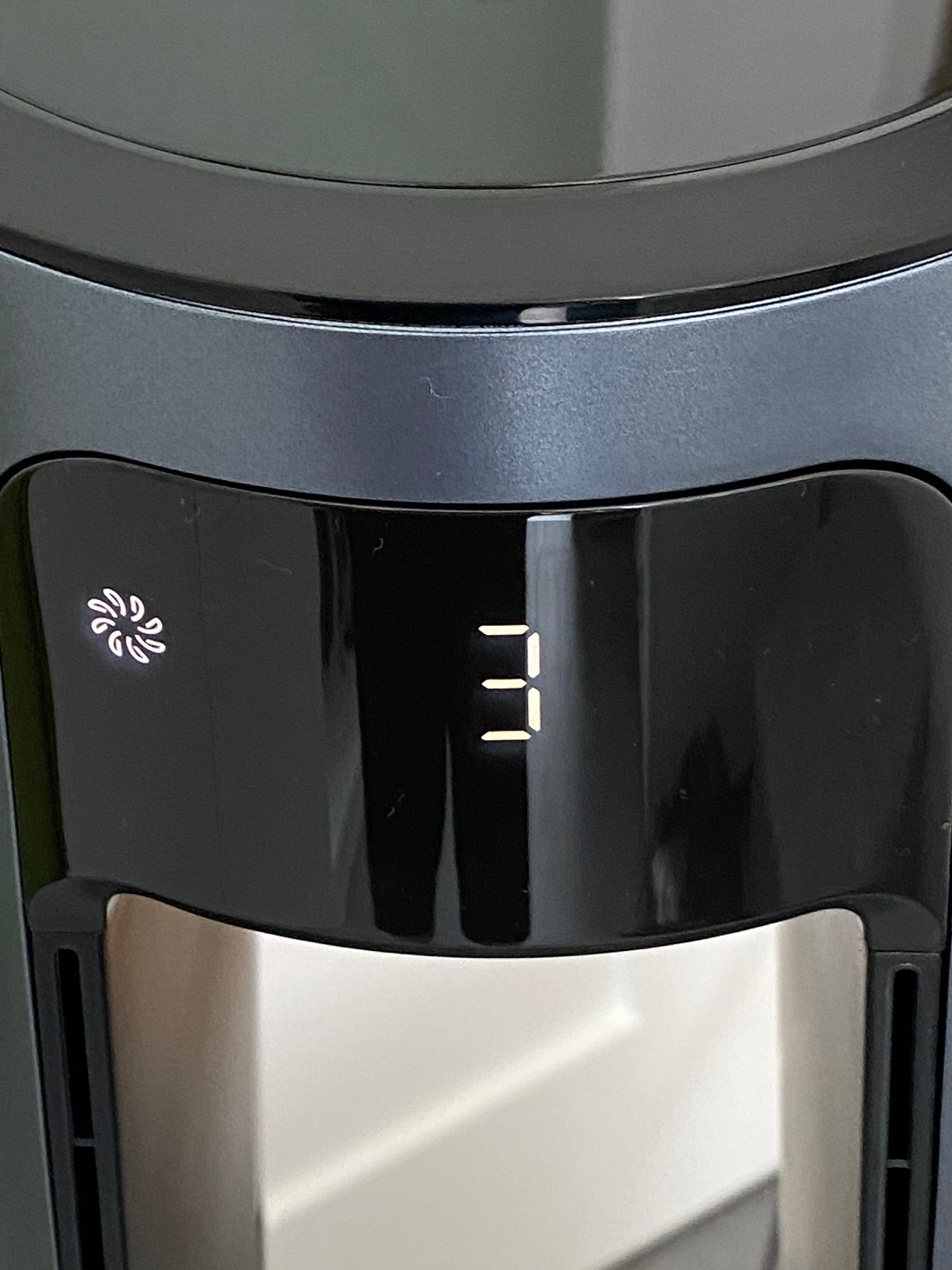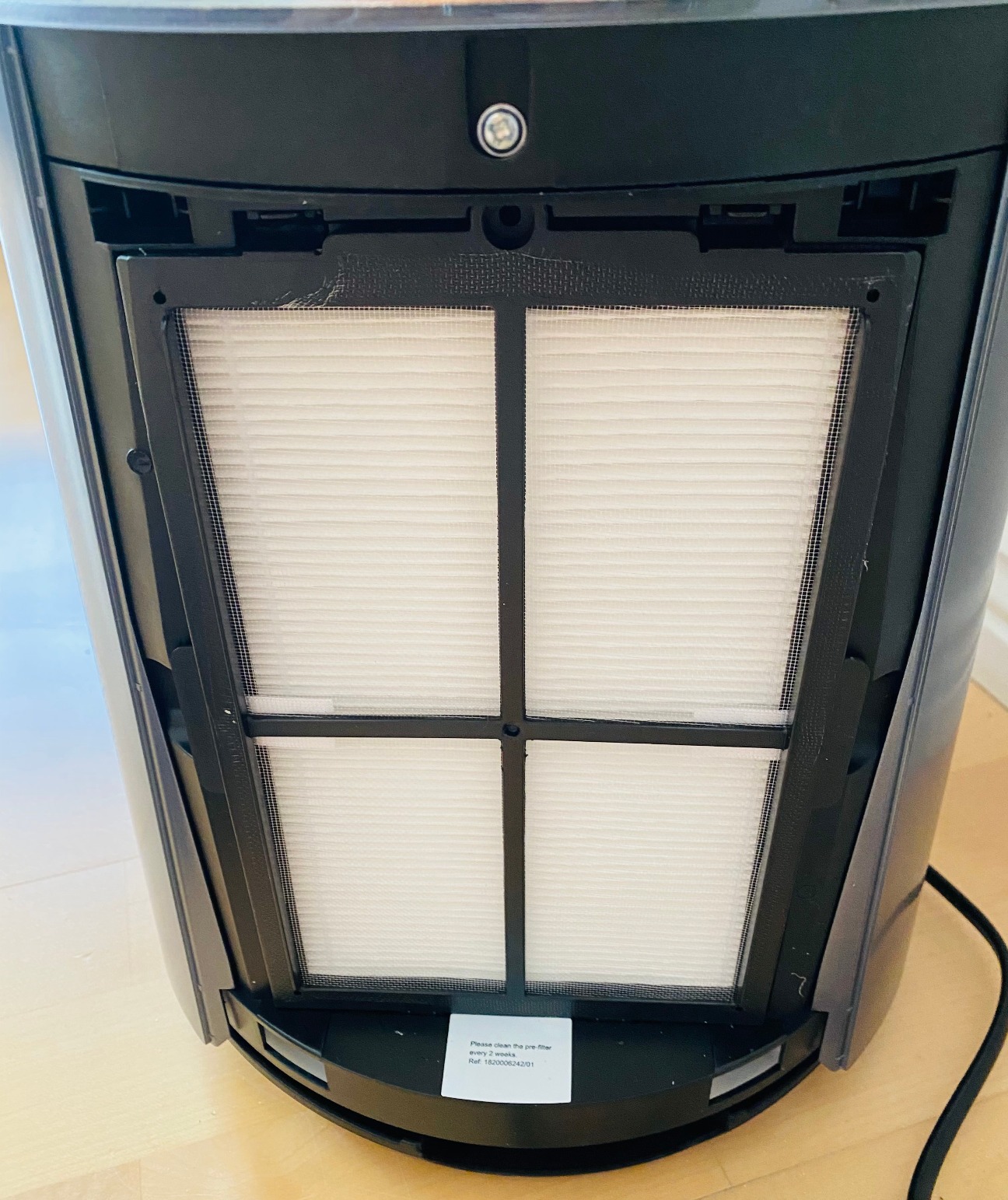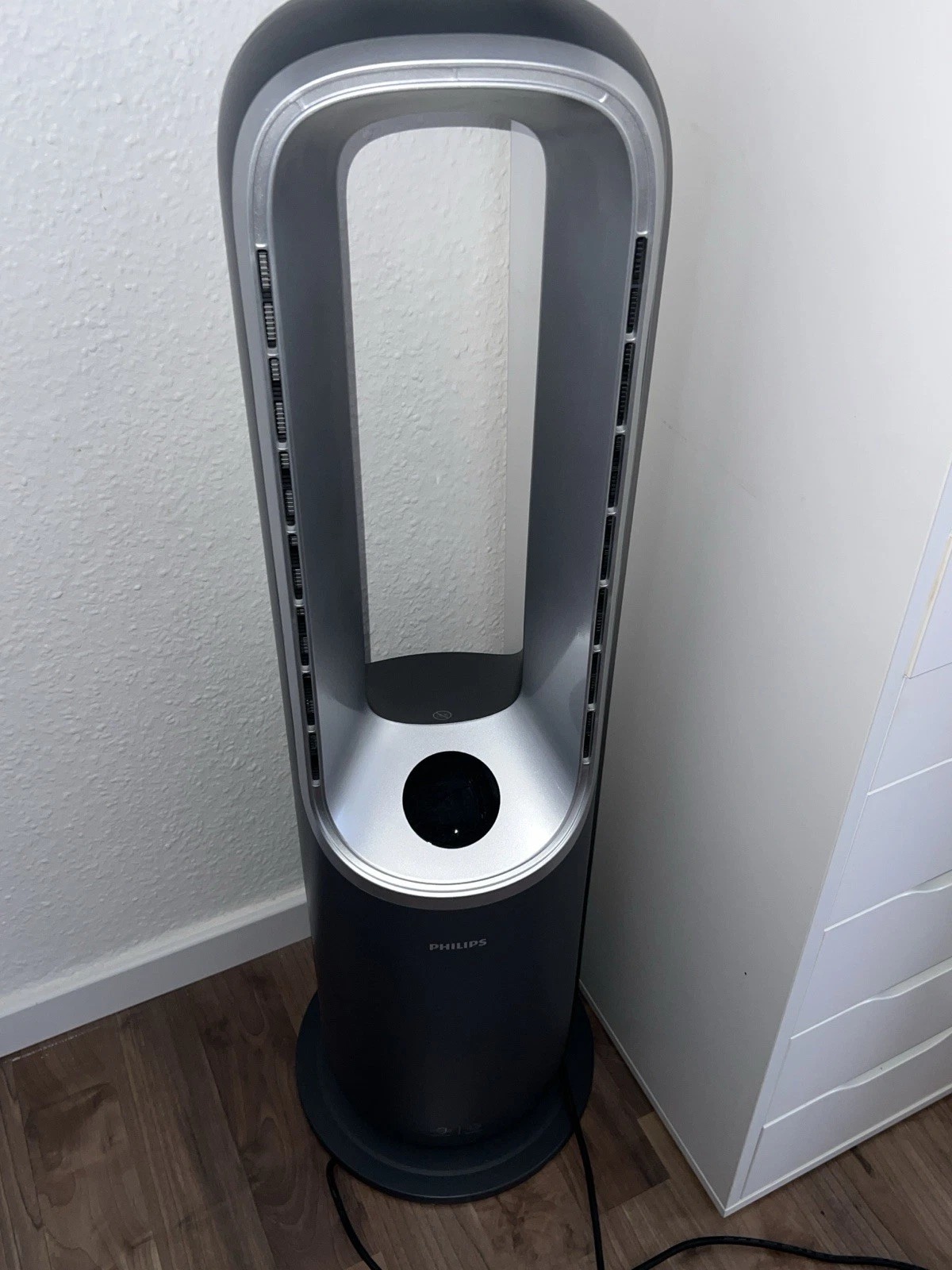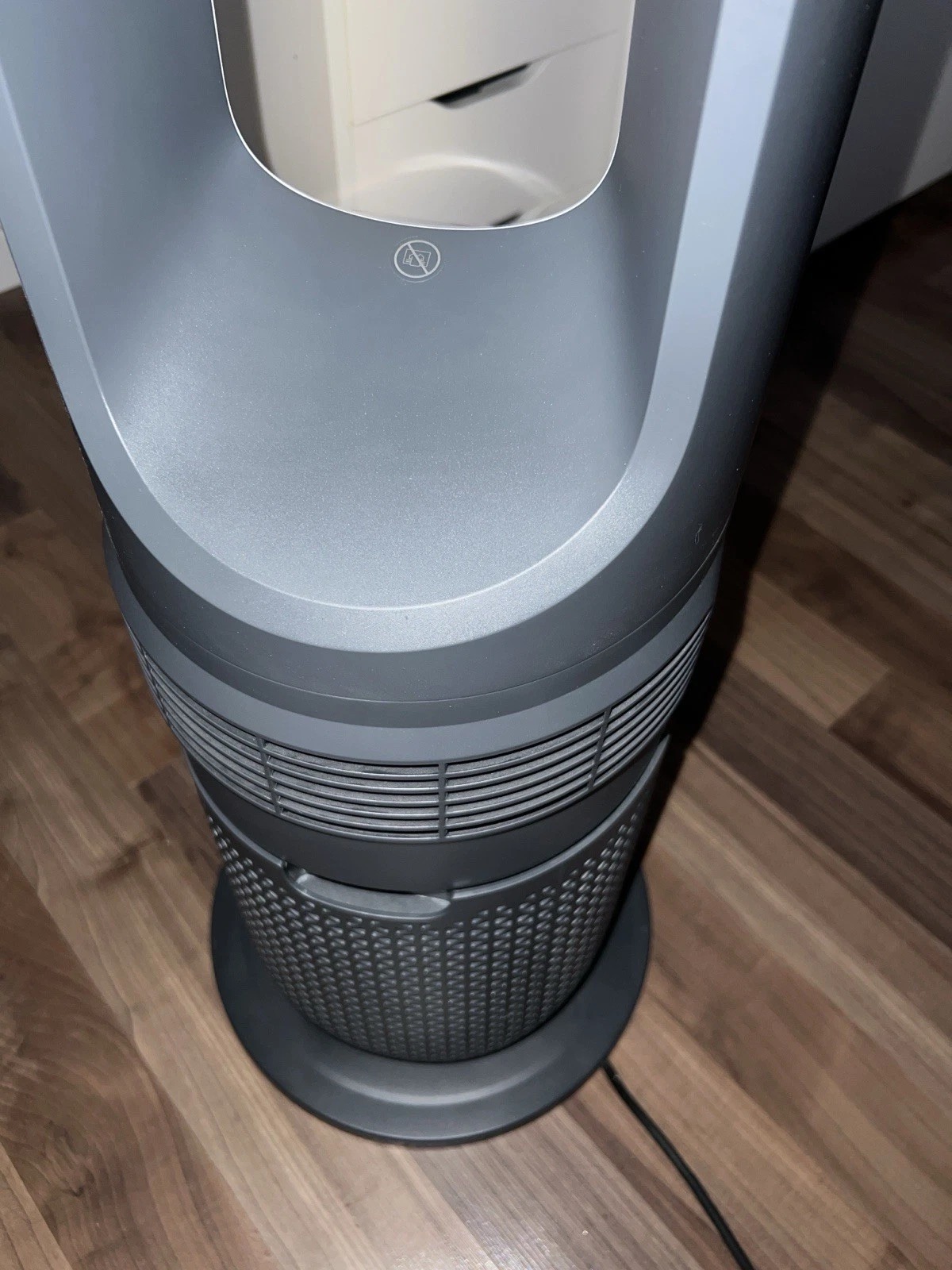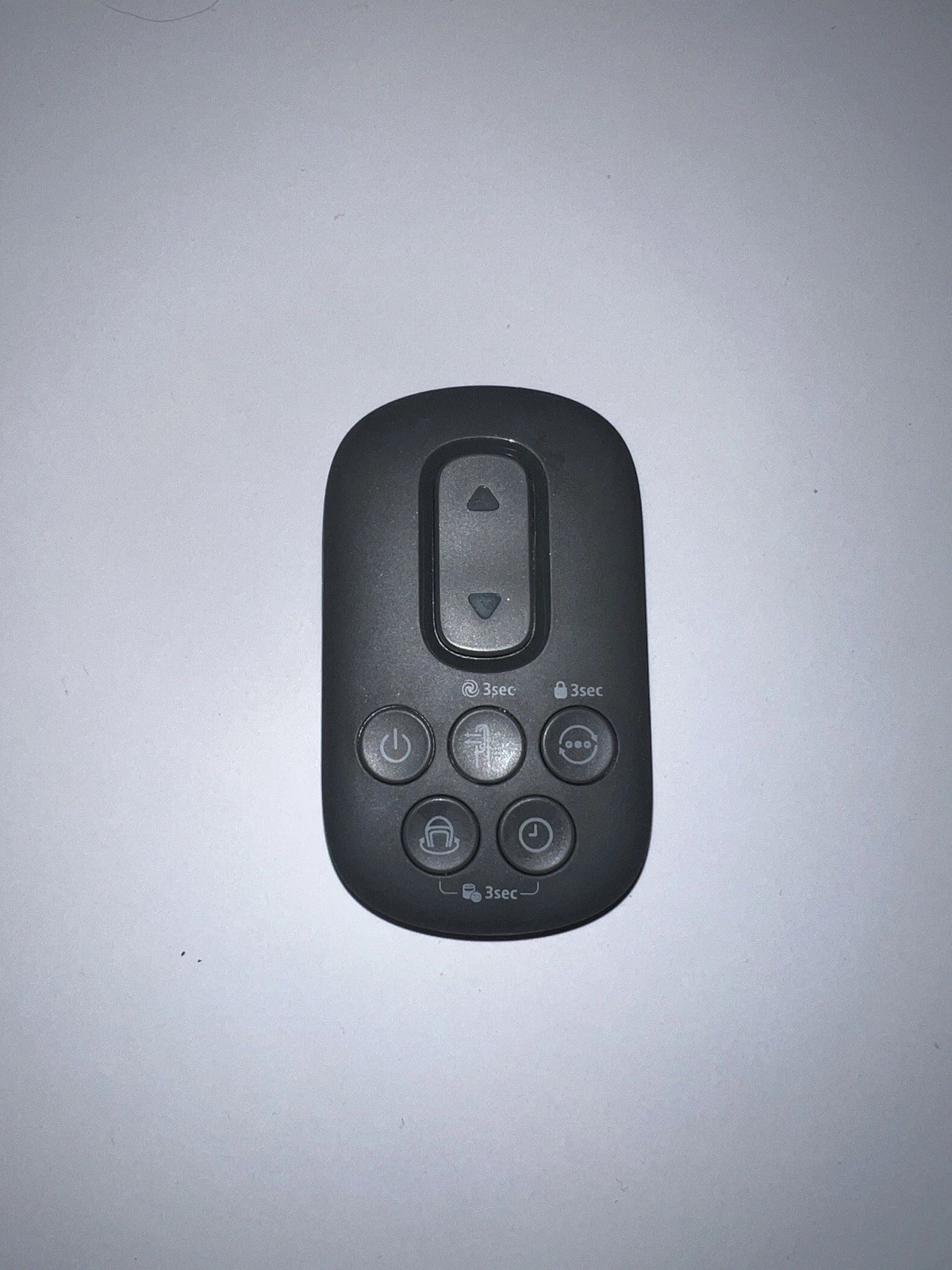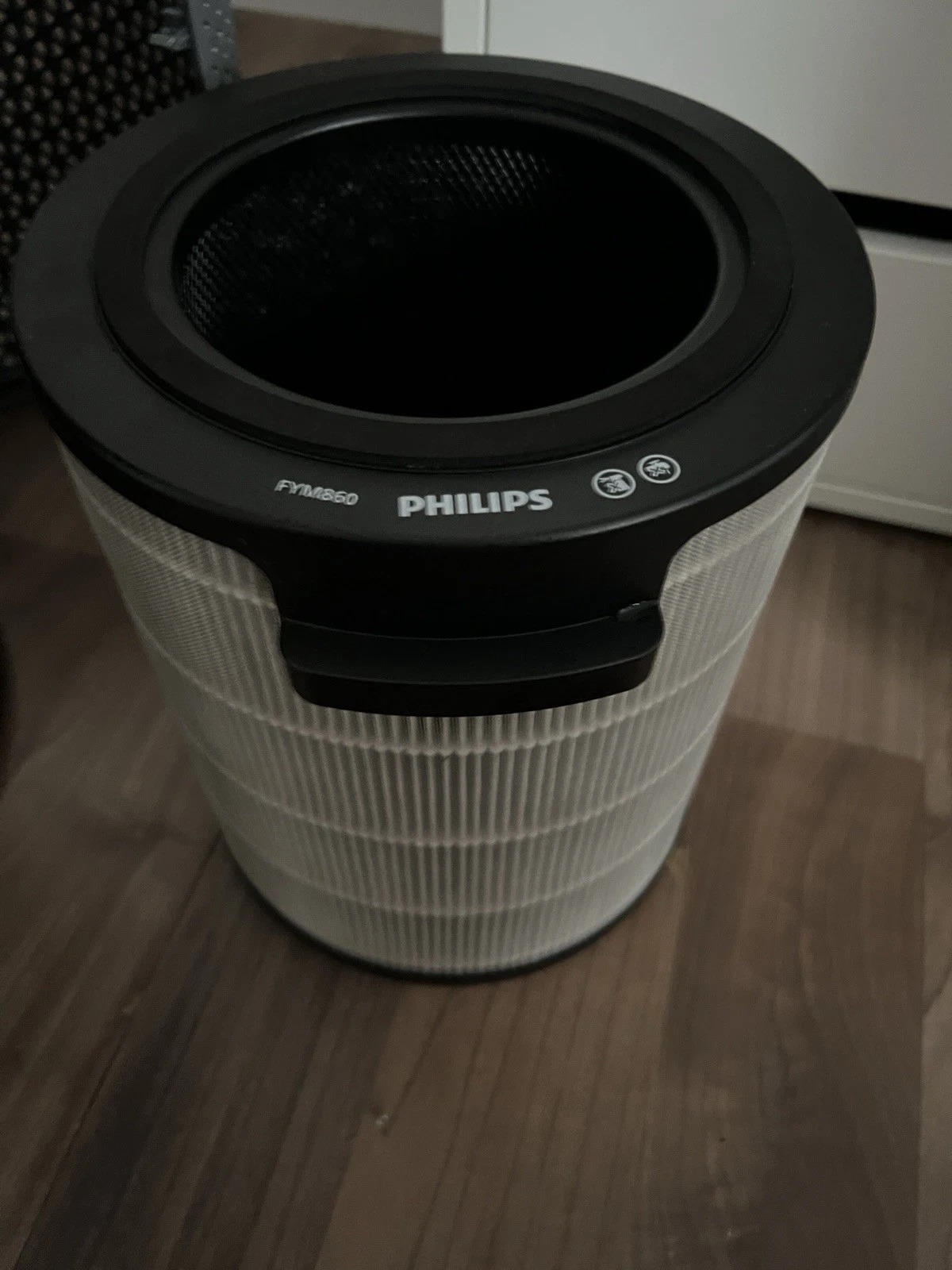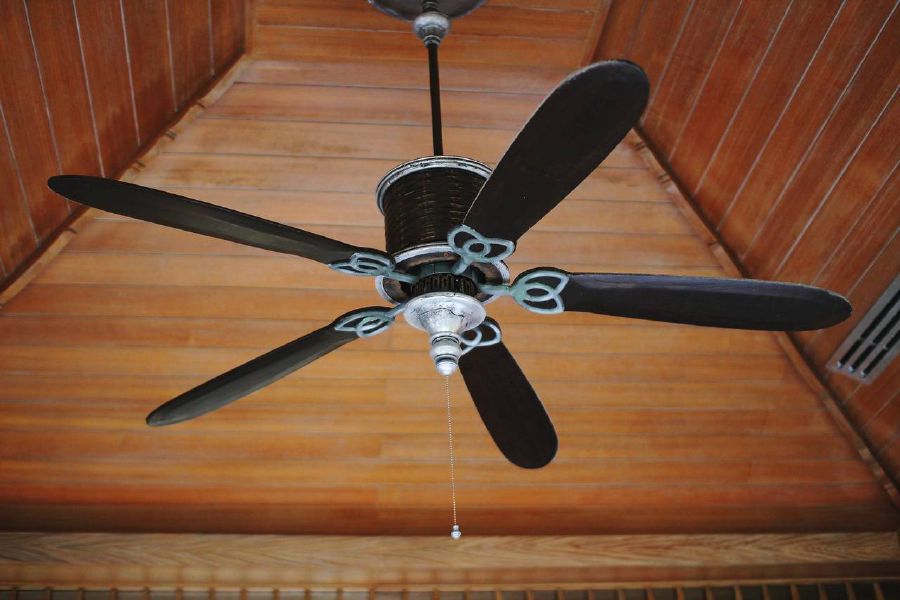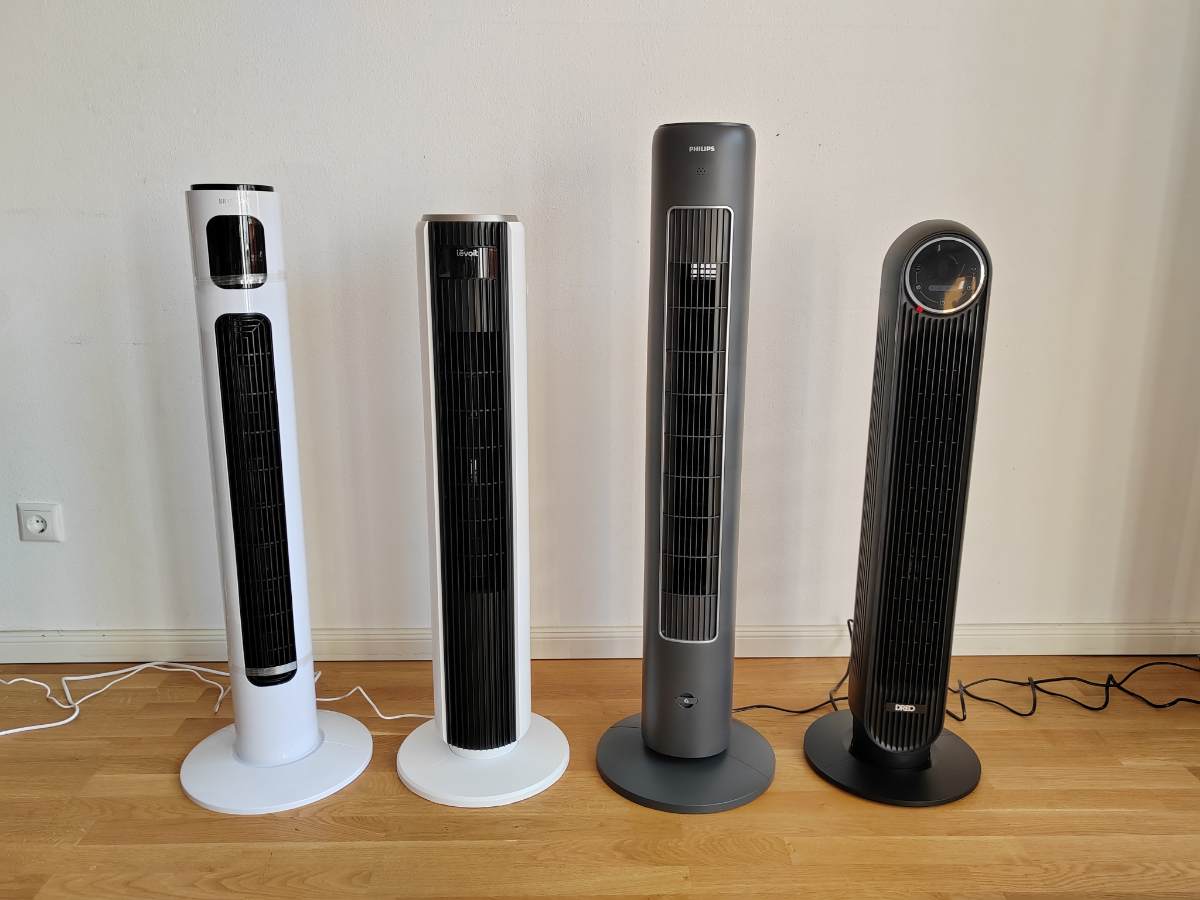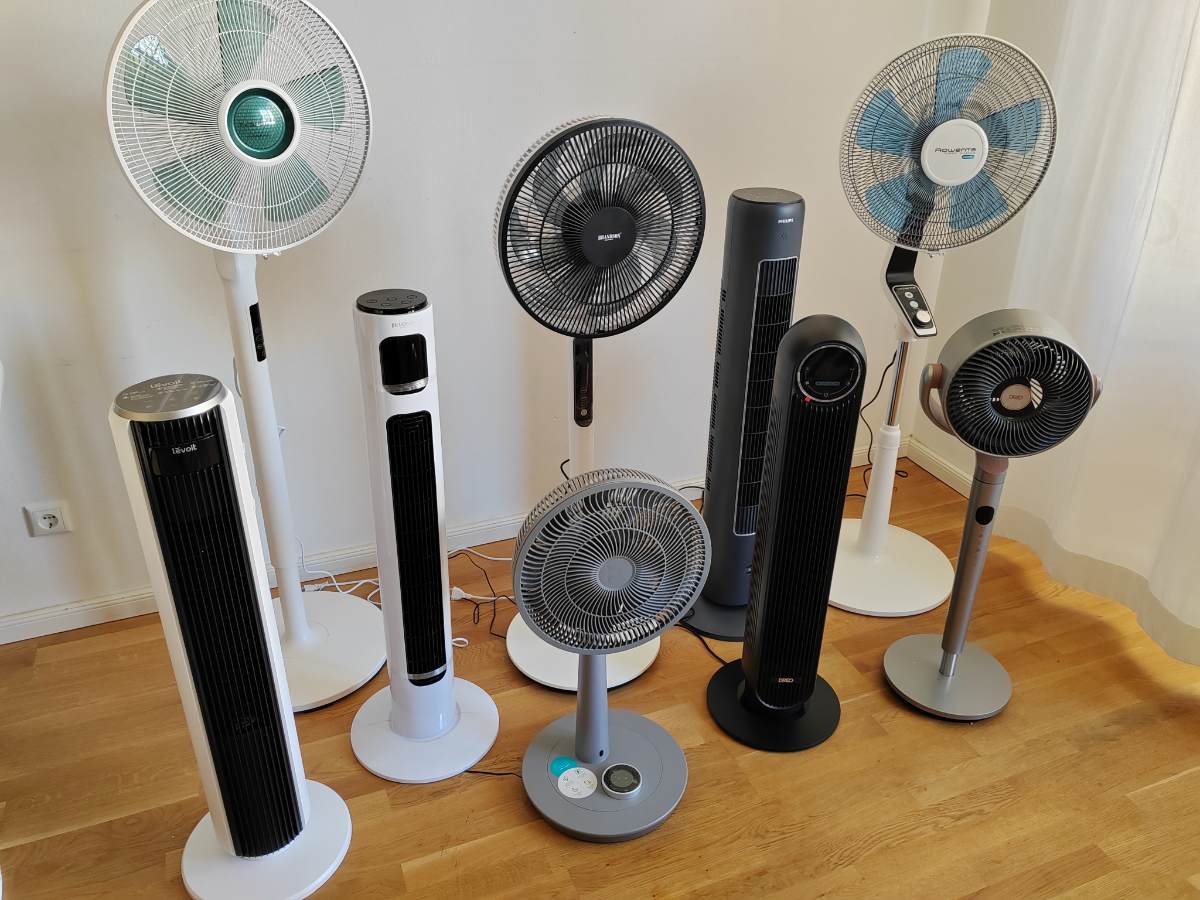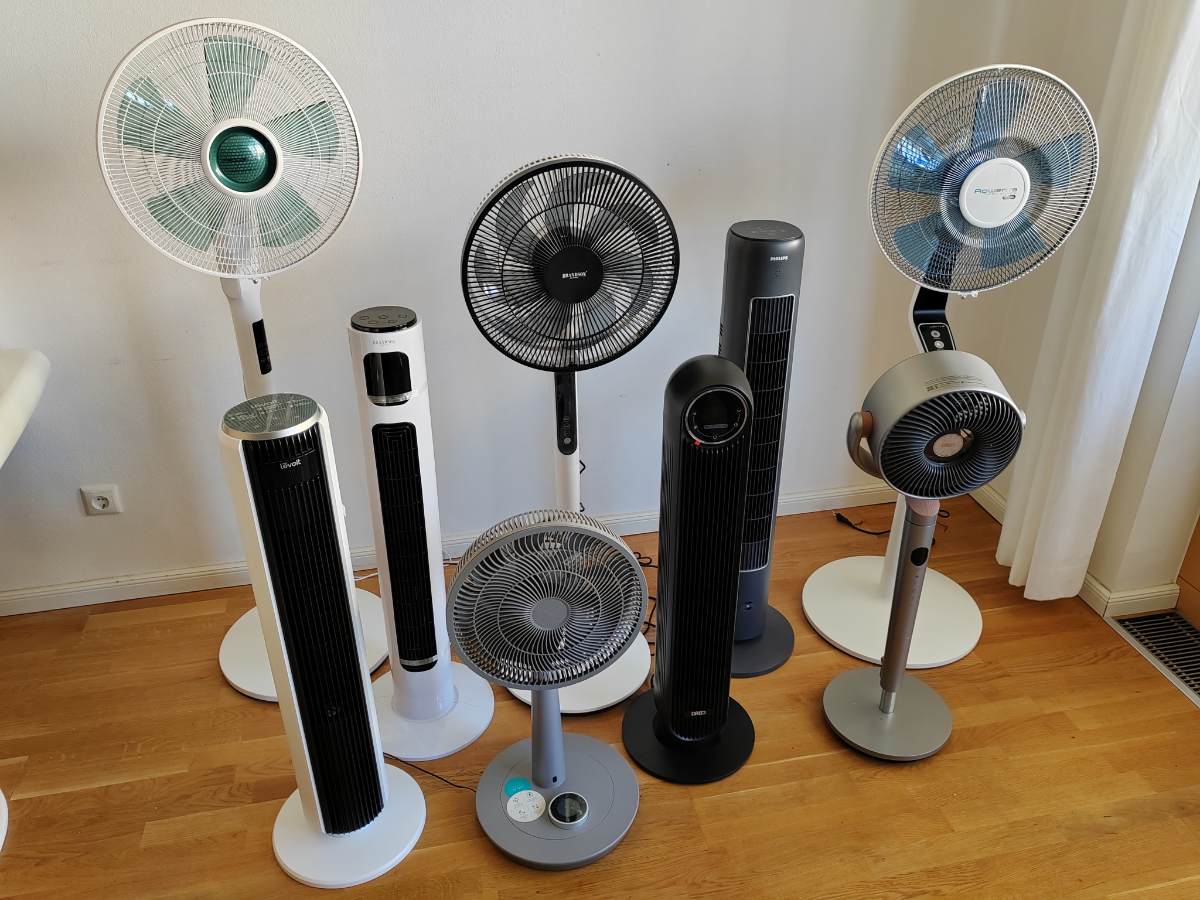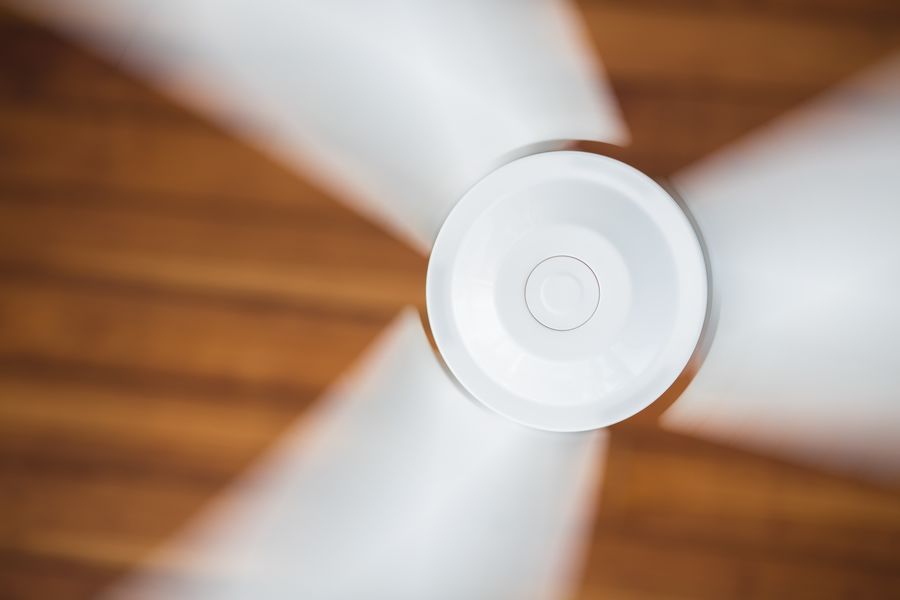Best Bladeless Fans in 2025 – Quiet, Safe & Stylish Cooling Compared
Rotorless fans are currently very popular. Visually, they are often superior to conventional table fans. The same applies to the range of functions. In terms of price, they are generally more expensive than fans with a rotor.
To be able to assess whether a rotorless is right for you, let's take a look at how it works. We then take a look at possible additional functions and the extent to which they are useful.
Recommended rotorless fans
Rotorless fan: How it works
For fans with a rotor, it is relatively clear which components push the air forwards. The shape of the blades in combination with the rotation pushes air in a certain direction:
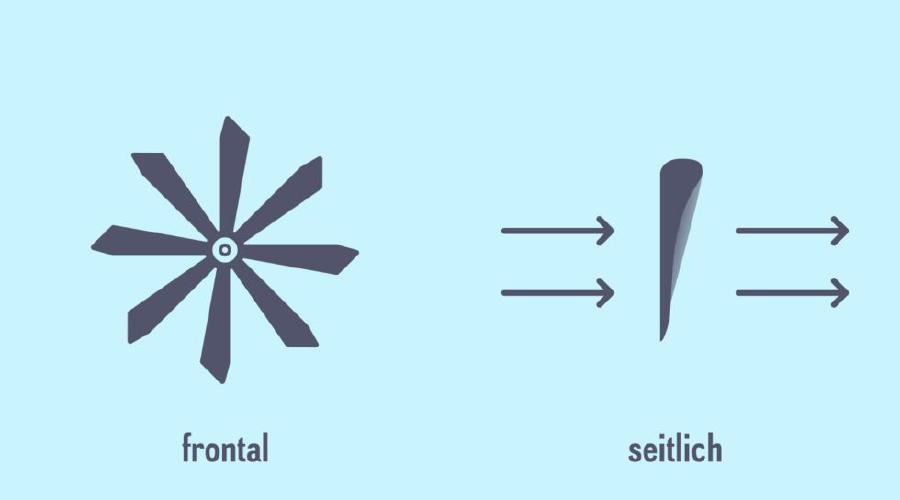
The illustration above shows how the rotor blade moves during rotation. The moment the rotor pushes the air in one direction, some air moves in from the opposite direction.
The illustration above shows a so-called Axial fan. With an axial fan, the air flow moves along the axis of rotation of the rotor. There are also centrifugal fans and tangential fans, for example.

The shape of the Centrifugal fan is reminiscent of a snail. Air is sucked in through the opening in the centre of the scroll and blown out at the outlet of the scroll. This type of fan is used when air is to be blown out at very high pressure.

A Cross-flow fan consists of a cylinder with individual louvres. The rotation causes the air to be sucked in on one side and expelled on the other. Such mechanisms can also be found in the Tower fans:
But how do rotorless fans work? In short, they also have a type of rotor, but it is not directly visible. For example, a centrifugal fan is installed in the base. This sucks in the air and then presses it through a usually ring-shaped opening:

The opening along the ring is relatively narrow, which accelerates the air pressed through it. If air is channelled through a wide opening, it tends to be slower. The narrower the opening (for the same amount of air), the greater its speed.
Advantages and disadvantages
Rotorless fans do not look like conventional fans. That's why they are a welcome change for many people. Visually, they look tidy and elegant. However, their advantages are not limited to their design. Their special mode of operation also harbours a number of advantages.
Uniform air flow
The ring-shaped design is no coincidence: the air flowing out of the opening of the ring creates an airflow that starts in front of the ring:
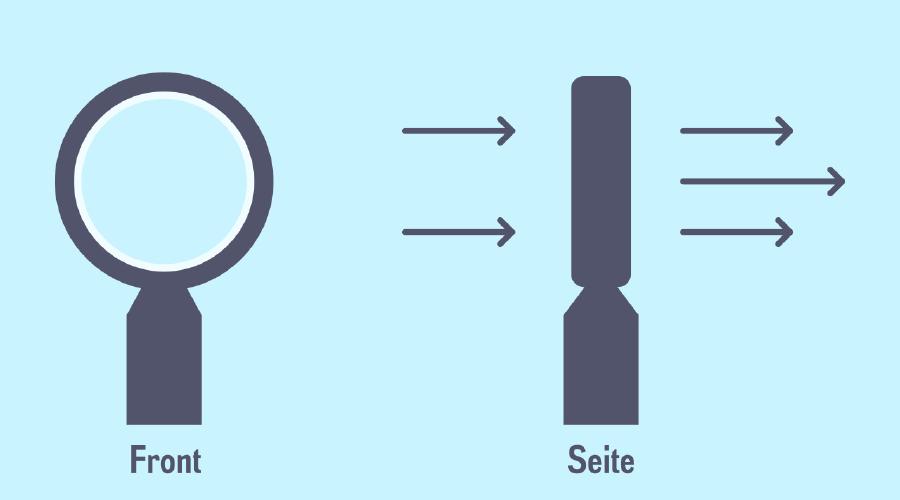
The air is pressed out of the opening along the ring. The resulting air movement also draws in air from the other side. This air passes through the ring and is further accelerated.
The result of this principle is a uniform air flow. Fans with a rotor, on the other hand, have a hub dead water. This refers to a point located just behind the centre of the rotor. Fans without a rotor have no such hub dead water and therefore a more uniform air flow.
Volume
The motor and rotor are housed in the base of the appliance. This means that the components that contribute significantly to noise generation are partially shielded. The noise level of rotorless models is therefore often lower than that of conventional appliances. If you are generally interested in particularly quiet appliances, these could be Quiet fans also be exciting for you.
Price
The price of these devices is often a disadvantage: they simply cost more. Whether the extra cost justifies the additional functions and benefits depends entirely on you. If the main thing for you is a pleasant air flow, then a device with a rotor is definitely worth it. If the design and noise level are also important, then it may be worth buying a rotorless alternative.
Cleaning
Cleaning rotorless fans is generally easier. Cleaning fans is usually limited to occasional dusting. The smooth surfaces and the absence of a mesh basket around the rotor make dusting easier.
There are models that have a built-in air filter have. These filters need to be replaced from time to time. How long a filter lasts depends on the model and usage. With active use, I would take a look at the filter every one to two months. It also doesn't hurt to take a look at the operating instructions. Manufacturers often provide information on the approximate service life of a filter.
Before buying a model with a filter, you should check how much the filters cost individually and where you can get them.
Recommended rotorless fans
Now that we have looked at the exact differences between the fans, let's take a look at the recommended models.
I have tried to compile a list that is as objective as possible. It should serve as a guide and clarify the weighting of the functions in relation to the price-performance ratio.
Test winner: Ultty rotorless fan - Combi for better sleep ( with video)
Anyone looking for a fan that can do more than just make wind should definitely take a look at the Ultty rotorless fan. It combines quiet cooling with an integrated HEPA air purifier - a concept that is particularly interesting for allergy sufferers, smokers or people in urban environments. I took a detailed look at the appliance - and was pleasantly surprised.
Whisper-quiet breeze & high air quality
What is immediately impressive is the volume - or rather, how little you hear of it. Even on the medium setting, the appliance runs so quietly that you almost forget it's on. Ideal for bedrooms, offices or the baby's room. The night mode, in which the display also dims automatically, is particularly practical. This ensures undisturbed sleep and a pleasantly cool room climate - without annoying buzzing or brightly lit numbers.
The integrated HEPA13 filter also does a solid job. According to the manufacturer, it removes 99.97 % of all ultra-fine particles - and you can tell. Many users report noticeably better air, freer breathing and fewer allergy symptoms. The device cleans the air five times per hour in an area of up to 20 m² - which is ideal for smaller rooms or bedrooms.
Operation & comfort
Operation is simple and well thought out. The LED touchscreen responds precisely, alternatively the fan can be conveniently controlled by remote control (unfortunately the beep sound cannot be deactivated) - particularly practical from the bed or sofa. There are 3 operating modes (standard, natural wind, sleep mode) and 9 speed levels available. A timer (up to 8 hours), 90° oscillation and a 30° adjustable air outlet are also included - a lot has really been thought of.
The air circulation is pleasantly even, and the rotorless design means there are no annoying air vortices or loud rotor noises. And this is a very reassuring safety solution, especially for households with children or pets.
Weaknesses? Reductions in power at high level
Where the Ultty can easily be beaten is in its absolute air performance. Anyone expecting a gale-force breeze at the highest level will be disappointed. Although air is still moved at level 9, compared to classic tower fans without an air filter, it simply lacks a bit of pulling power. It also gets noticeably louder at the highest level - a classic problem with fan/air purifier combinations that have to work harder due to the filter.
But if you prefer it to be gentle, quiet and with added value, this is the right place for you.
Conclusion
The Ultty tower fan is not a wind maker for heat battles - but a stylish, well thought-out all-rounder for permanently better air and pleasant cooling in everyday life. Particularly recommended for sensitive sleepers, allergy sufferers or parents looking for a safe, quiet device. If you want maximum power, you should also buy a classic fan - but for everything else, the Ultty is a real recommendation.
👉 Watch the video to see for yourself - from the whisper-quiet lowest level to full power at the highest level!
No products found.
djive ARC Casual 2-in-1 - Smart air purifier with style
The djive ARC Casual is one of those modern combination appliances that make you wonder: Why hasn't this been around for much longer? A tower fan with HEPA 14 air purifier and app control that runs as quiet as a whisper, looks good and fits into any living room? That's exactly what the djive has to offer - and in my everyday life it has proven to be a versatile companion.
Quiet & efficient - ideal for everyday use
With a noise level of just 29 dB, the djive ARC is one of the quietest devices in its class. It runs virtually unnoticed in the bedroom - even at night, which makes it particularly suitable for sleeping. At the same time, it ensures even air circulation, which is pleasantly gentle but noticeable. And thanks to the HEPA 14 filter, the room air is thoroughly cleaned - even the finest particles such as pollen or house dust are removed.
I was particularly impressed by the display of fine dust pollution (PM2.5). After airing the room or doing a match test, I was able to easily understand the reaction speed of the sensor. If you're a bit tech-savvy like me, you'll be delighted. One small detail: the filter display can drop somewhat prematurely to "0 %" - but the filter does not necessarily have to be replaced immediately, as one user has proven with simple tests.
App, Alexa, Google - it could hardly be smarter
The app is a real highlight. It is stable, easy to use and offers many automated functions - from schedules and air quality triggers to control via voice assistants such as Alexa or Google Home. This makes operation flexible, even when you're not at home. The humidity can also be viewed via the app, which can be particularly helpful in winter.
Good workmanship, minor weaknesses
The design is simple and modern - in "Clean White" it cuts a fine figure in any corner. Operating the appliance itself works reliably, even if the remote control is a little clunky. A little dexterity is required when inserting the filter, as it occasionally gets stuck here. The colour of the housing can flake off slightly at the edges over time - not visually tragic, but still a point.
One small drawback is that no settings are saved when the appliance is disconnected from the mains. This is a shame, especially if you change the device frequently. There is also no HomeKit integration - a minor drawback for Apple users.
Conclusion
The djive ARC Casual is a sophisticated, smart combination appliance for anyone who wants a good indoor climate - quiet, powerful and stylish. A clear recommendation for allergy sufferers, technology enthusiasts or simply comfort fans. The optional humidifier attachment is not a must - the basic appliance is already impressive across the board.
Rowenta rotorless 2 in1 air cleaning fan - Quiet, stylish, powerful
The Rowenta Eclipse QU5030 is a real all-rounder: rotorless fan, air purifier and - depending on the model - even with a heating function. I scrutinised the 2-in-1 model and was curious to see whether the combination of function and design would also be convincing in practice.
Design & workmanship - more than just an eye-catcher
The Rowenta Eclipse has a high-quality finish, a modern design and looks great - especially in modern living spaces. Operation is intuitive, both directly on the appliance and by remote control. Assembly is simple and the filters can be inserted in no time at all. A nice detail: the packaging uses very little plastic - a plus point in terms of sustainability.
Whispering operation with real effect
The fan is one thing above all: quiet. Barely audible in silent mode, it is a pleasant companion without annoying background noise, even at night. The air is distributed evenly and efficiently - up to 8 metres away according to the manufacturer. Ideal for medium-sized to large rooms. Thanks to 12 speed levels and two operating modes (night & auto), the intensity can be optimally adjusted. Particularly practical: in auto mode, the device regulates the power automatically based on the ambient temperature.
Another highlight is the integrated air purifier with two high-performance filters. These remove up to 99.95 % of all fine particles - perfect for allergy sufferers, pet owners or anyone who simply wants to enjoy better indoor air. User reports confirm noticeable improvements in the indoor climate and fewer allergy complaints.
Minor points of criticism? Yes, but not a dealbreaker
The remote control could be of a slightly higher quality for a device in this price range - but it is functionally flawless. The 2-in-1 model has no app control at all, which is somewhat surprising considering its otherwise smart appearance. In addition, the device is not exactly lightweight - anyone who wants to transport it frequently between floors should keep this in mind.
Conclusion
The Rowenta Eclipse QU5030 is a sophisticated, powerful appliance that not only cools but also cleans the air effectively. It is a real asset for people with allergies or sensitive sleep patterns. The design, range of functions and low noise level are just right - and justify the slightly higher price.
Philips Air Performer 2-in-1 - Air purifier & cooling fan
The Philips Air Performer 2-in-1 really surprised me - in the best sense of the word. At first glance, the appliance looks high-quality and modern, and this feeling continues throughout its use. I tested it both as an air purifier and as a fan, and it performs very well in both disciplines.
Quiet power with smart control
What is immediately noticeable is the volume. Even when running, the Air Performer is extremely quiet - barely audible, especially in night mode. Ideal for the bedroom or even the living room if you just want to relax. A slight noise is only audible from level 4 - and even that is much more pleasant than with many other appliances.
It can be controlled either directly on the device, using the remote control supplied or conveniently via the app. The latter offers many functions, but I have to say: there is still room for improvement here. I repeatedly experienced connection problems. Switching it on and off usually helped, but the connection wasn't really stable. A software update could help here.
Cleaning performance & sensor technology
When it comes to air purification, the appliance impresses with the well-known Philips NanoProtect HEPA filter system. This removes dust, allergens and even fine particles from the air. I found the real-time display of the air quality particularly exciting - after vacuuming, the value jumped from 3 to a whopping 250, which honestly shocked me. A real eye-opener, especially indoors with high levels of fine dust pollution.
The sensors basically work reliably, but I miss an automatic function like the smaller Philips air purifiers, which switch the appliance off completely when the air quality is good. Instead, the Air Performer continues to run continuously in AI mode - the rotary function also remains active. For me, it would be logical to also pause the movement or operation when the air quality is ideal.
Design & ease of use
Visually, the device is a real eye-catcher. The finish is elegant and the materials are of high quality. The magnetic holder for the remote control is practical - even if it could be positioned a little better.
The air circulation control works smoothly. You can switch between air purification and ventilation - perfect for different seasons. The slow rotation is particularly pleasant as it moves unobtrusively and gently through the room.
One small point of criticism: two bright dots remain visible even when the display backlight is deactivated. This can be annoying for light-sensitive people in the bedroom - the only thing that helps here is the plug.
Conclusion
The Philips Air Performer 2-in-1 is a successful all-round appliance with strong filter performance, very quiet operation and a high-quality look. Especially in combination with the app and the smart functions, it offers a good overall package - even if some points such as the app stability or the behaviour in AI mode could still be optimised. For city dwellers, allergy sufferers or anyone who values a good indoor climate, the appliance is a real recommendation.
Dyson Cool AM07 fan with remote control
The Dyson Cool AM07 is one of the best-known rotorless fans. Dyson simply has expertise in the manufacture of these devices.
Visually, the device looks tidy and modern. In contrast to conventional fans, it is less conspicuous in the room. This should make it easier to integrate it into the décor of a room.
The strength of the air flow can be set between 10 intensity levels can be selected. At the lower levels, the AM06 remains very quiet and thus plays to the strengths of this product category in terms of noise reduction. Low noise emission from.
To ensure that not just one area of the room benefits from the air flow, the AM06 can automatically swivel back and forth. With this Oscillation it covers an angle of 75°. The upper part can also be tilted slightly - by a total of 10°. This allows the fan to reach you even when it is standing on a low side table, for example.
In addition to the control panel directly on the product, it can be operated via the Tower Fans with Remote Control can be controlled. There is a magnetic holder on the top for the latter.
If the fan is to be used in the bedroom, then the Switch-off timer on. It switches the appliance off automatically after a selected period of time.
For me, the AM07 has landed in first place because it has the most important functions and is also energy-saving. It comes with 56Watt and measures at a distance of 1m 33db (lowest level) and approx. 66dB (highest level). In my eyes, this is absolutely justifiable.
Midea MFP-120i (BL)- Smart rotorless fan with air purifier
The Midea MFP-120i (BL) joins the class of stylish, rotorless 2-in-1 fans - with air purification, app control and particularly quiet operation. I tested the model over several days and was curious to see whether it could keep up with more expensive devices such as Dyson. This much in advance: it offers an amazing amount - especially for the money.
Whisper-quiet & safe: ideal for children's rooms, offices and bedrooms
With a Noise level of only 38 dB the fan runs barely audibly even when in operation. This makes it perfect for quiet rooms such as bedrooms or home offices. Even in "sleep mode", operation remains pleasantly quiet - many even report that they were able to sleep much better thanks to the gentle airflow.
As the device is completely bladeless there are no rotating parts - a real safety advantage in households with children or pets. And on top of that, it simply looks chic: The Slim, dark blue design fits into any modern interior.
Functionality with app & Alexa - almost perfect
The App control via smartphone is a success. It runs smoothly, allows many settings and offers more than the supplied remote control - which unfortunately comes in white, which is a little visually confusing. Also Alexa is compatibleHowever, it can only be used for basic functions such as switching on and off. Fine settings such as fan levels or modes are not (yet) integrated - a pity, but not a deal-breaker.
A real plus is the option to tilt the air outlet slightly and switch on oscillation, which ensures pleasant air distribution. The output is set to Shorter distances ideal - in larger rooms, the appliance should be placed nearby.
Air purification & processing - light and shade
The integrated air purifier works - even if no exact values are given for the filter class. Users report an improved indoor climate and less dust. However, the temperature display is somewhat inaccurate (shows approx. 3 °C too much) and the plastic of the filter grille seems less robust.
Another small shortcoming: The operating buttons are not illuminated in the dark. This can be annoying at night if you want to change something spontaneously. Also: Replacement filters are currently difficult to obtainwhich somewhat restricts long-term use.
Conclusion
The Midea MFP-120i offers a lot for the money: rotorless design, powerful app functions, quiet operation and air purification - perfect for anyone who appreciates quiet nights and smart convenience. There are minor weaknesses in the material details and smart Alexa integration, but these are easy to overcome in the overall package. A real recommendation for under €150.
Compared to the AM06, the Pure Cool Link has a few more extras. These include the option to control it via the corresponding app.
This app can also be used to Information about the indoor air can be read off. The values are measured directly by the fan. These include the temperature, humidity and air quality - indicated in the Air Quality Index [ 1 ] .
More convenient, however, is the Sensor control. With the installed measuring instruments the device recognises falling air quality and switches on automatically at the appropriate time.
The air filter is installed in the base of the appliance. The sucked-in air is channelled through and filtered in this way. The Air purification is an advantage, but the need to Change filter a disadvantage.
With a power consumption of 40 watts this fan is significantly higher than the 26 watts of the AM06. I suspect that this is due to the filter. Passing the air through it additionally costs more energy.
Like the AM06, this fan can be swivelled back and forth at an angle of 70° if required. The upper part can also be tilted by 10°.
The Sichler appliance is a cheaper alternative. The design distinguishes it from other rotorless fans. It is both swivelling as well as tiltable. Can be swivelled by 80° and tilted by 120°.
It does not have an air filter, but it does have a Tower Fans with Remote Control. The Automatic switch-off can be set to either one or two hours. After the time has elapsed, the appliance switches itself off.
The main advantage of this model is its relatively low price. However, it lacks a few practical functions. Nevertheless, this fan appears in my ranking list to cover this price range as well. The bottom line is that it is a solid Entry-level model.
FAQs on rotorless fans
A rotorless fan utilises a special technology in which the air is drawn in through the base and then accelerated through a ring-shaped slot in the upper part of the appliance. This airflow creates an even and constant airflow without the use of visible rotor blades.
Rotorless fans offer several technical advantages: they are safer as there are no open rotor blades, they are quieter in operation and generate a more even air flow. They are also easier to clean as there are no grilles or rotor blades in the way.
Yes, rotorless fans are generally energy efficient. The technology is designed to maximise airflow while minimising energy consumption. Many models also have energy-saving modes and timers to further reduce power consumption.
Rotorless fans are generally quieter than conventional fans with rotor blades. They produce a smoother airflow without the typical noise of rotating blades, which makes them particularly suitable for quiet environments such as bedrooms or offices.
The advantages of rotorless fans include increased safety due to the absence of rotor blades, quiet operation, ease of cleaning and a modern, aesthetic appearance. They also generate a more continuous airflow and are often equipped with additional functions such as air purification or heating modes.
On the contrary, rotorless fans are very easy to clean. As they do not have rotor blades that collect dust, they are much easier to clean. It is sufficient to wipe the outer surfaces occasionally to keep the fan clean.
Conclusion
See rotorless fans more modern are equipped with nice functions and work quietly. But they cost considerably more. In addition, there are only Few manufacturersthat sell such models. This limits the choice. Where there are hundreds, if not thousands of models of conventional fans, there are at most a few dozen.
If low noise development is important to you, then Tower fans a suitable alternative.
Sources
[1] ↑ https://aqicn.org/scale/de/
